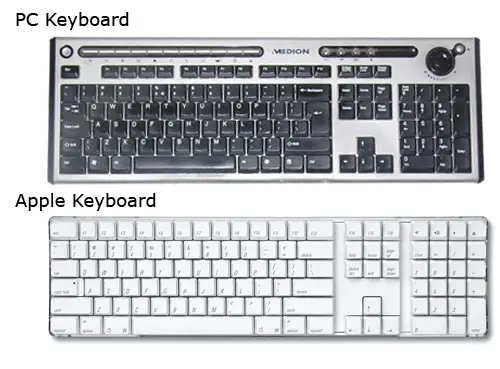
- #Mac command key on windows keyboard mac os x
- #Mac command key on windows keyboard Pc
⌥ Option+ ↑/ ↓ – navigate to the head/end of current paragraph. ⌥ Option+ ←/ → – navigate to the previous/next word. In text areas, the Option key can be used for quick keyboard navigation. It is common for such controls - that is, those whose behavior is governed by a preference - to be invertible in this way The preference in this case is which way to rotate the image: If the user changes the default rotation direction in the Preferences to clockwise, holding down Option will make the button rotate counterclockwise instead, and vice versa. The iPhoto example is an example of a control whose behavior is governed by a preference which is temporarily inverted by holding down the Option key. #Mac command key on windows keyboard mac os x
Menu bar items – the Sound icon will show Audio Device input / output settings instead of the volume control slider, the battery item will show the condition of the battery, the MobileMe sync item will show the last sync date/time of individual synced items and will offer additional menu items such as Sync Diagnostics, and the Wireless icon will show extended wireless network information and, in Mac OS X Lion, offer an item for launching a Wi-Fi diagnostic application (when AirPort is connected). iPhoto – the rotate image button toggles between a "rotate right" and a "rotate left". Holding Option and clicking the green Window Zoom (+) button at the top-left forces the iTunes window into fullscreen view, rather than switching between the user-set window size and the iTunes Mini Player. iTunes – the Create Playlist button switches to a Create Smart Playlist button. Dock – the Option key causes the "Hide" and "Quit" menu items in the context menu of a Dock icon to switch to "Hide Others" and "Force Quit". This functionality is a de facto Macintosh standard and available in numerous other programs. Consequently, clicking a window's close box with the option key depressed invokes "close all" as well. Safari, Finder – the Option key causes the "Close Window" menu item to switch to "Close All Windows" when pressed down. The key is also used to provide for alternative menu items and buttons when pressed down. For example, ⌥ Option+ Return typically produces a line break that is not interpreted as a paragraph break. The Option key is often used in conjunction with special keys like Tab ↹, delete, and return to provide alternate functions. Notice that holding the shift key as well as the option key while pressing a letter key may create "capital" versions of what results when the same letter key is pressed while the option key but not the shift key is held. If an r is pressed instead, the two characters are not compatible so the result is `r. For example, holding down ⌥ Option while pressing ` will create a highlighted grave accent which will be added to the next letter if possible – so if an e is then pressed, the resultant character is è. The Option key can also provide access to dead key functionality. English keyboard input, ⌥ Option+ a produces the " å" character, and ⌥ Option+ 4 produces the cent sign "¢". 

The options available differ depending on the keyboard input locale that the user has selected. The use of the Option key is similar to that of the AltGr key on European keyboards of IBM-compatible PCs, in the sense that it can be used to type additional characters, symbols and diacritical marks. Use of the Option key Alternative keyboard input
#Mac command key on windows keyboard Pc
In this regard, it is akin to the AltGr key, found on some IBM-compatible PC keyboards. It is not used to access menus or hotkeys, but is instead used as a modifier for other command codes, and also to provide easier access to various accents and symbols. The Option key in a Mac operating system functions differently from the Alt key under other Unix-like systems or Microsoft Windows. Since the 1990s, "alt" has sometimes appeared on the key as well, for use as an Alt key with non-Mac software, such as Unix and Windows programs as of 2017, the newest Apple keyboards such as the Magic Keyboard no longer include the "alt" label. From 1980 to 1984, on the Apple II series, this key was known as the closed apple key, and had a black line drawing of a filled-in apple on it. (As of 2005, some laptops had only one to make room for the arrow keys.)Īpple commonly uses the symbol U+2325 ⌥ OPTION KEY to represent the Option key. There are two Option keys on modern (as of 2020) Mac desktop and notebook keyboards, one on each side of the space bar. It is located between the Control key and Command key on a typical Mac keyboard. The Option key is a modifier key present on Apple keyboards.

The Option key may be labeled Alt, Option, ⌥, or any combination thereof.







 0 kommentar(er)
0 kommentar(er)
